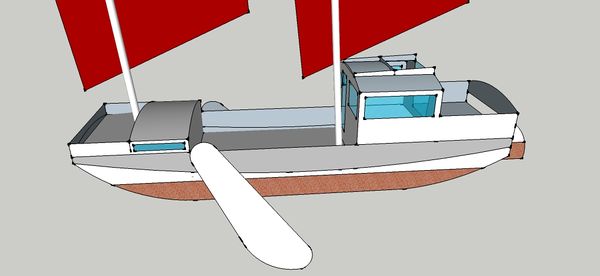Triloboat: Difference between revisions
Dave Zeiger (talk | contribs) m (Change 'Introductio' to 'Overview' and expand) |
Dave Zeiger (talk | contribs) m (Typo fix) |
||
| Line 52: | Line 52: | ||
* High end curves meet waves better, but reduce flat-water speed, displacement and buoyancy, and interior volume. | * High end curves meet waves better, but reduce flat-water speed, displacement and buoyancy, and interior volume. | ||
* Every partial sheet generates lofting, cut-out and waste, but increase options. Simple fractions of sheets yielding round numbers (1, 1/2, 1/3, 1/4, 1/6, 1/8)generate less waste, and make for simple layout. Consider design for whole sheets where possible, and larger fractions where not. | * Every partial sheet generates lofting, cut-out and waste, but increase options. Simple fractions of sheets yielding round numbers (1, 1/2, 1/3, 1/4, 1/6, 1/8) generate less waste, and make for simple layout. Consider design for whole sheets where possible, and larger fractions where not. | ||
* Curves take time, but reduce hull resistance, and in the superstructure shed water, add headroom and aesthetics | * Curves take time, but reduce hull resistance, and in the superstructure shed water, add headroom and aesthetics | ||
Revision as of 19:32, 17 April 2012
TriloBoat Overview
TriloBoats were designed by Dave Zeiger as a formula generated class of box barge (or scow) hulls based on construction from sheet materials.
The rules-of-thumb generate hundreds of instances in a wide array of sizes and functional layouts. Potential layouts include kayak, skiff, cargo, houseboat, cruisers and multihulls. They are compatible with sail and power.
The rules-of-thumb are selected to simplify construction for dramatic savings in time, energy, material and money.
With his partner, Anke Wagner, Dave has built three instances of TriloBoat, to date, including S/V SLACKTIDE, their home for the last three years. For further information, discussion, construction and sailing photos, please visit http://www.triloboats.com, and http://triloboats.blogspot.com.
TriloBoat Hull Rules-of-Thumb
- Hulls are simple, box barges - rectangular in plan and section views.
- Hulls are constructed from whole and simple-fraction multiples of rectangular, off-the-shelf, sheet materials.
- Hull beam is one sheet.
- Hull length is scalable, generally in multiples (or combinations) of full length sheets.
- Hull curves are limited to the ends (generally one quarter the LengthOfHull) , reducing lofting, layout, spiling, cutting, beveling and bending to bare minimums.
- Hull curves are separated by a dead-flat (planar section of bottom, generally one half the LengthOfHull).
- Hulls are self-rectifying and jig-less (consequences of these rules).
- All controlling numbers are rationalized (rounded), where possible, to maximize mnemonic retention, communication and accuracy.'
TriloBoat Superstructure Rules-of-Thumb
- Superstructures are constructed from whole and simple-fraction multiples of rectangular, off-the-shelf, sheet materials.
- Side decks are not used (flush decks maximize strength, simplify construction and assist ventilation).
- All decks are planar (sloped to drain), pitched or section-of-cylinder (simple layout and construction).
- Where section-of-cylinder decks are used, upper hull or superstructure are canted inboard to provide slack for a single sheet span of desired crown.
- All controlling numbers are rationalized (rounded), where possible, to maximize mnemonic retention, communication and accuracy.
TriloBoat Trade-Offs
- As one cuts away from the original prism (the rectangular slab formed by length x beam x draft), one reduces interior volume and displacement while reducing resistance through the water.
- High end curves meet waves better, but reduce flat-water speed, displacement and buoyancy, and interior volume.
- Every partial sheet generates lofting, cut-out and waste, but increase options. Simple fractions of sheets yielding round numbers (1, 1/2, 1/3, 1/4, 1/6, 1/8) generate less waste, and make for simple layout. Consider design for whole sheets where possible, and larger fractions where not.
- Curves take time, but reduce hull resistance, and in the superstructure shed water, add headroom and aesthetics
